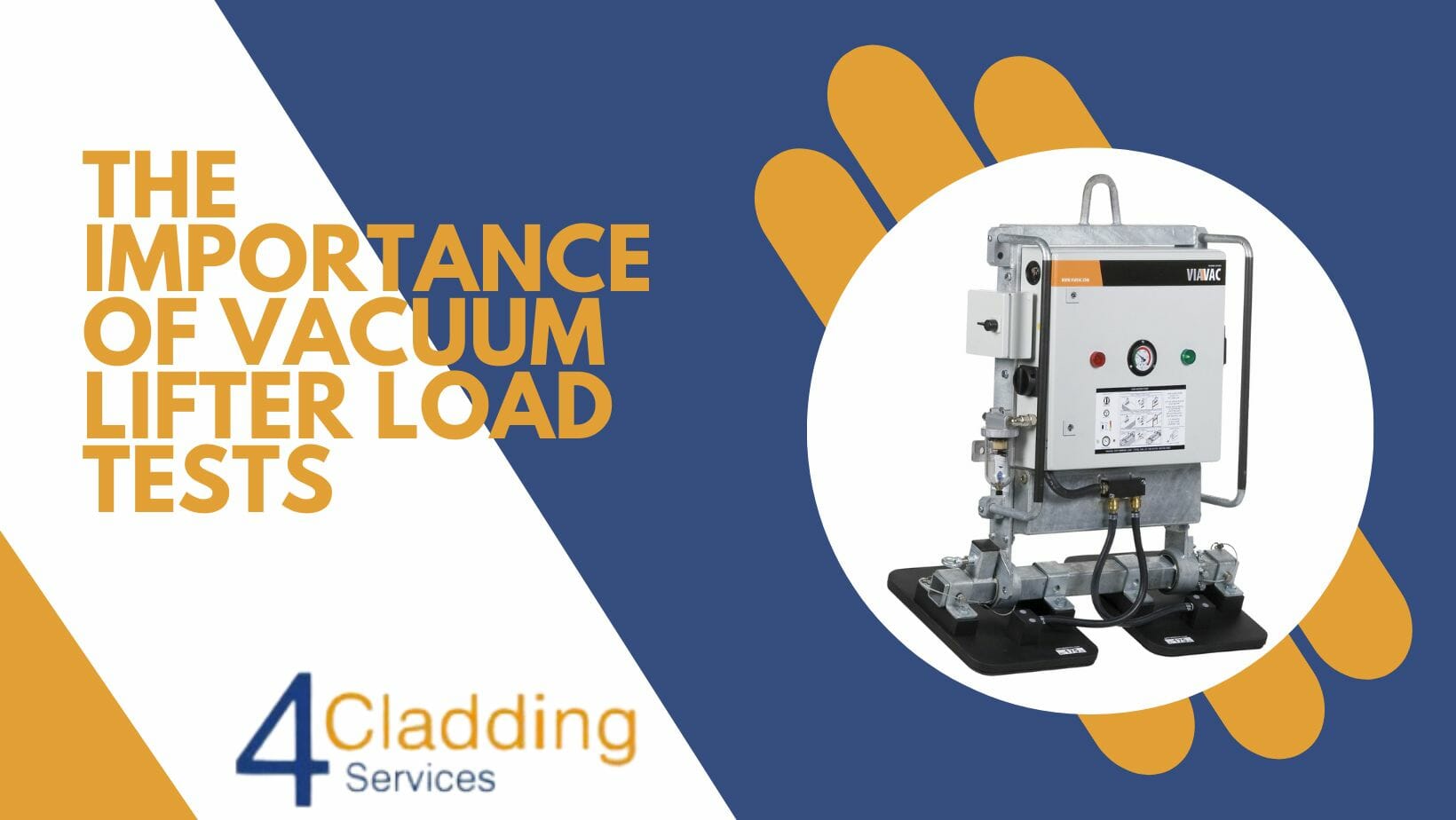
The construction industry is a realm where precision and caution intersect, and at 4 Cladding, safety stands as the cornerstone of our ethos. We’re resolute in our commitment to ensuring that every practitioner who wields a vacuum lifter does so with unwavering confidence in its reliability. In our comprehensive guide, we delve into the pivotal role of load tests and provide an easy-to-follow roadmap to effectively conducting these tests.
Understanding Vacuum Lifters: Unleashing Efficiency and Power
Imagine moving massive panels, glass sheets, or heavy building materials with ease. This is the remarkable capability of vacuum lifters. These mechanical marvels exemplify efficiency, but their prowess also comes with an implicit responsibility to ensure they operate within stringent safety parameters.
How Vacuum Lifters Work
At the heart of a vacuum lifter lies the vacuum pad, a rubber or silicone suction cup that adheres to the load’s surface. A vacuum is created by evacuating the air between the pad and the material, generating an atmospheric pressure that firmly holds the load in place. This straightforward yet ingenious mechanism renders vacuum lifters versatile tools capable of lifting various materials, from concrete slabs to delicate glass panels.
The Role of Load Tests: Unveiling Vulnerabilities, Validating Strength
When it comes to construction, safety is the linchpin holding every operation together. This principle is particularly magnified when dealing with heavy-lifting equipment like vacuum lifters. Enter load tests, the unsung heroes of equipment reliability and operator security.
Unveiling the Essence of Load Tests
Imagine a high-rise construction project requiring the precise positioning of massive glass panels. The vacuum lifter’s efficiency is undeniable, but load tests step in before it takes centre stage. These tests are like stress tests for lifting equipment, designed to push the equipment to its limits and expose any vulnerabilities.
The Purpose Behind Load Tests
Load tests serve a dual purpose, identifying equipment weaknesses and validating operational strength. Essentially, they’re akin to a medical check-up, providing insights into the lifter’s health. By simulating real-world conditions, load tests ensure the equipment can handle designated loads without compromising safety.
Vital Components of a Load Test
A load test isn’t just a heavy-duty experiment; it’s a meticulously orchestrated process:
- Precise Simulation: The test replicates actual lifting scenarios, considering factors like weight, angle, and positioning.
- Incremental Stress: Load is gradually increased on the lifter to gauge capacity. This meticulous approach unveils potential weak points.
- Safety First: Stringent safety protocols are maintained throughout the test to prevent accidents and ensure operator well-being.
Enhancing Operator Safety
The paramount reason for load tests is to enhance operator safety. The implications of a lifter failure during a lifting operation are dire. By subjecting the equipment to controlled stress in a test environment, load tests detect vulnerabilities that might compromise safety in real-world scenarios. This preventive approach spares lives and prevents catastrophic accidents.
Preserving Equipment Longevity
Load tests aren’t just about immediate safety and contribute to the lifter’s longevity. Load tests extend the equipment’s operational life by detecting and addressing issues early on. This translates into cost savings, minimised downtime, and optimised project timelines.
Industry Regulations and Standards
In construction, adherence to regulations isn’t optional; it’s mandatory. Load tests stand as a bridge between equipment performance and regulatory compliance. They validate that the lifter meets industry standards, positioning companies as responsible stakeholders committed to safety and operational excellence.
Conducting Load Tests: A Procedural Breakdown
When the safety and reliability of heavy lifting equipment are at stake, meticulousness is paramount. Load tests, the quintessential assessments for vacuum lifters, are not mere routine checks. They’re systematic examinations that require careful preparation and execution. Let’s dive into the steps of conducting load tests effectively.
1. Preparation: Creating a Controlled Environment
Before a load test, ensure the testing environment mirrors real-world conditions. This means having the equipment, calibrated gauges, and trained personnel. Safety should take centre stage, including safety barriers and measures to prevent accidents.
2. Methodical Execution: A Gradual Approach
The essence of a load test lies in its gradual nature. Start with an initial load well within the lifter’s operational capacity. Slowly increase the load in predetermined increments, ensuring the equipment remains stable and operational at each stage.
3. Vigilance and Safety Precautions
Throughout the test, maintain unwavering vigilance. Monitor the lifter for any signs of stress, deformation, or unusual behaviour. Safety protocols, such as proper operator positioning and gear, must be strictly followed.
4. Observing Performance
As the load increases, observe how the vacuum lifter responds. It should exhibit stability, with no signs of buckling or imminent failure. If there are any concerning indicators, the test should be stopped immediately to prevent accidents.
5. Data Collection and Analysis
During the test, collect accurate and comprehensive data. This data includes load increments, lifter behaviour, and any anomalies observed. This information is crucial for a detailed analysis of the lifter’s performance.
6. Deciphering the Results: Fit for Duty or Adjustments Needed
After the test, the collected data is thoroughly analysed. If the vacuum lifter successfully withstands the prescribed loads without exhibiting weaknesses, it’s deemed fit for operational use. On the other hand, if issues or concerns emerge, prompt adjustments or repairs are required.
7. Documentation and Records
Proper documentation of the load test is essential. Record the entire test procedure, from preparation to results. These records serve as evidence of compliance and provide a historical reference for future assessments.
Safeguarding the Future of Construction
From enhancing operator safety and prolonging equipment longevity to ensuring compliance with industry standards, load tests play an irreplaceable role in the construction narrative. They aren’t just about numbers and weights; they’re about the lives of workers, the success of projects, and the reputation of businesses.
As you navigate the intricacies of construction, remember that load tests are your allies in a journey where safety is paramount. At 4 Cladding, we don’t just emphasise the importance of load tests. We live and breathe safety in every facet of our work. If you’re seeking guidance on vacuum lifter training, safety protocols, or maintenance for your vacuum lifter, don’t hesitate to get in touch with our expert team.
Related Articles
Choosing the Right Vacuum Lifter for Your Application
How Does a Vacuum Lifter Work?
Vacuum Lifters: An Efficient Solution for Handling Composite Panels in the UK
